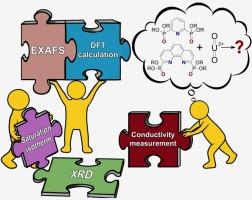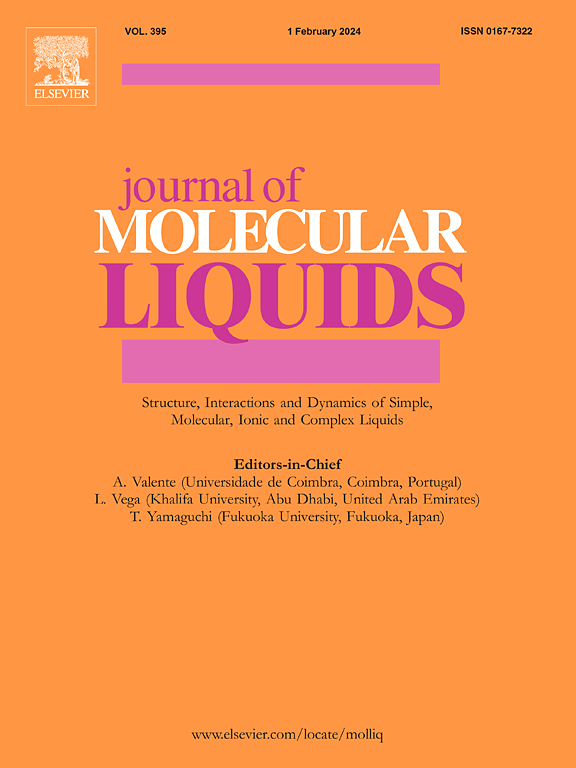揭示多齿配体在极性溶剂中进行铀(VI)溶剂萃取的机理:离子对的作用
IF 5.2
2区 化学
Q2 CHEMISTRY, PHYSICAL
引用次数: 0
摘要
铀是核能的关键元素。为铀的纯化和浓缩开发新的萃取系统是改善核燃料循环的一项重要任务。在这项工作中,对溶剂萃取和铀酰与三齿吡啶基和四齿菲罗啉基二膦酸盐的络合物进行了深入细致的研究,包括有机相和固态。实验方法(负载等温线和电导率测量)、光谱技术(紫外-可见光、EXAFS、31P NMR 和拉曼光谱)和理论计算相结合,揭示了溶剂萃取铀(VI)的机理。我们证明,四价菲罗啉配体会形成紧密的离子对([UO2LNO3]+[UO2(NO3)3]-)。在三叉配体的作用下,U(VI)会形成具有不同化学计量的混合络合物。与有机溶液中的络合物相比,固态三叉配体络合物的结构也有显著差异。本文章由计算机程序翻译,如有差异,请以英文原文为准。

Disclosing the mechanism of uranium(VI) solvent extraction by polydentate ligands in a polar solvent: The role of ion pairs
Uranium is a key element in nuclear power. Developing new extraction systems for its purification and concentration is an important task for improving the nuclear fuel cycle. In this work solvent extraction and uranyl complexes with tri-dentate pyridine-based and tetra-dentate phenanthroline-based diphosphonates were studied in thorough detail, both in the organic phase and the solid state. A combination of experimental methods (loading isotherms and conductivity measurements), spectroscopic techniques (UV–vis, EXAFS, 31P NMR, and Raman spectroscopy) and theoretical calculations were used to disclose the mechanism of U(VI) solvent extraction. We demonstrated that with tetradentate phenanthroline-based ligands, tight ion pairs ([UO2LNO3]+[UO2(NO3)3]−) are formed. With tridentate ligands, U(VI) forms a mixture of complexes with different stoichiometries. Significant differences in the structure of complexes with tridentate ligands in the solid state compared to complexes in the organic solution were also shown.
求助全文
通过发布文献求助,成功后即可免费获取论文全文。
去求助
来源期刊

Journal of Molecular Liquids
化学-物理:原子、分子和化学物理
CiteScore
10.30
自引率
16.70%
发文量
2597
审稿时长
78 days
期刊介绍:
The journal includes papers in the following areas:
– Simple organic liquids and mixtures
– Ionic liquids
– Surfactant solutions (including micelles and vesicles) and liquid interfaces
– Colloidal solutions and nanoparticles
– Thermotropic and lyotropic liquid crystals
– Ferrofluids
– Water, aqueous solutions and other hydrogen-bonded liquids
– Lubricants, polymer solutions and melts
– Molten metals and salts
– Phase transitions and critical phenomena in liquids and confined fluids
– Self assembly in complex liquids.– Biomolecules in solution
The emphasis is on the molecular (or microscopic) understanding of particular liquids or liquid systems, especially concerning structure, dynamics and intermolecular forces. The experimental techniques used may include:
– Conventional spectroscopy (mid-IR and far-IR, Raman, NMR, etc.)
– Non-linear optics and time resolved spectroscopy (psec, fsec, asec, ISRS, etc.)
– Light scattering (Rayleigh, Brillouin, PCS, etc.)
– Dielectric relaxation
– X-ray and neutron scattering and diffraction.
Experimental studies, computer simulations (MD or MC) and analytical theory will be considered for publication; papers just reporting experimental results that do not contribute to the understanding of the fundamentals of molecular and ionic liquids will not be accepted. Only papers of a non-routine nature and advancing the field will be considered for publication.
 求助内容:
求助内容: 应助结果提醒方式:
应助结果提醒方式:


